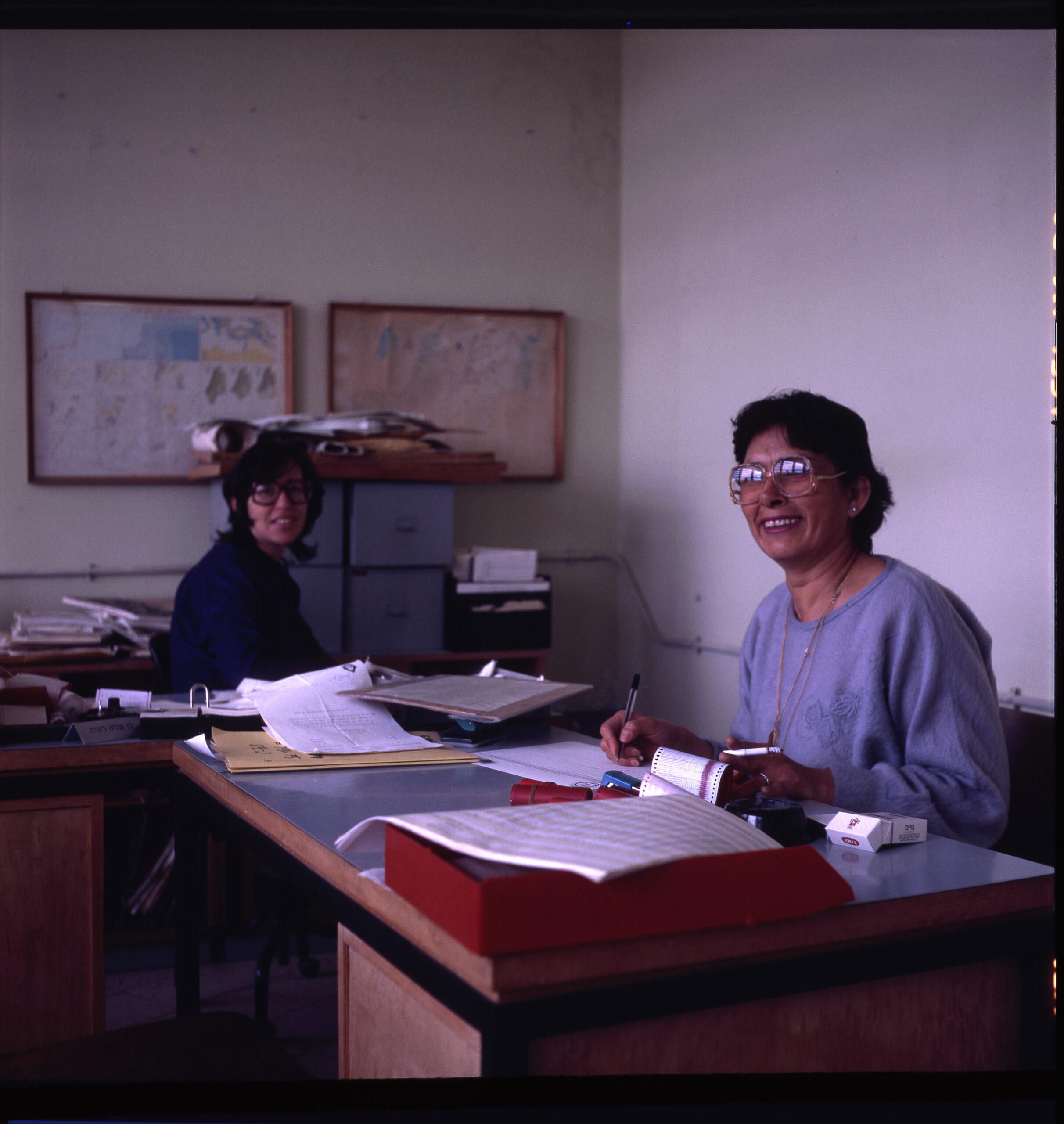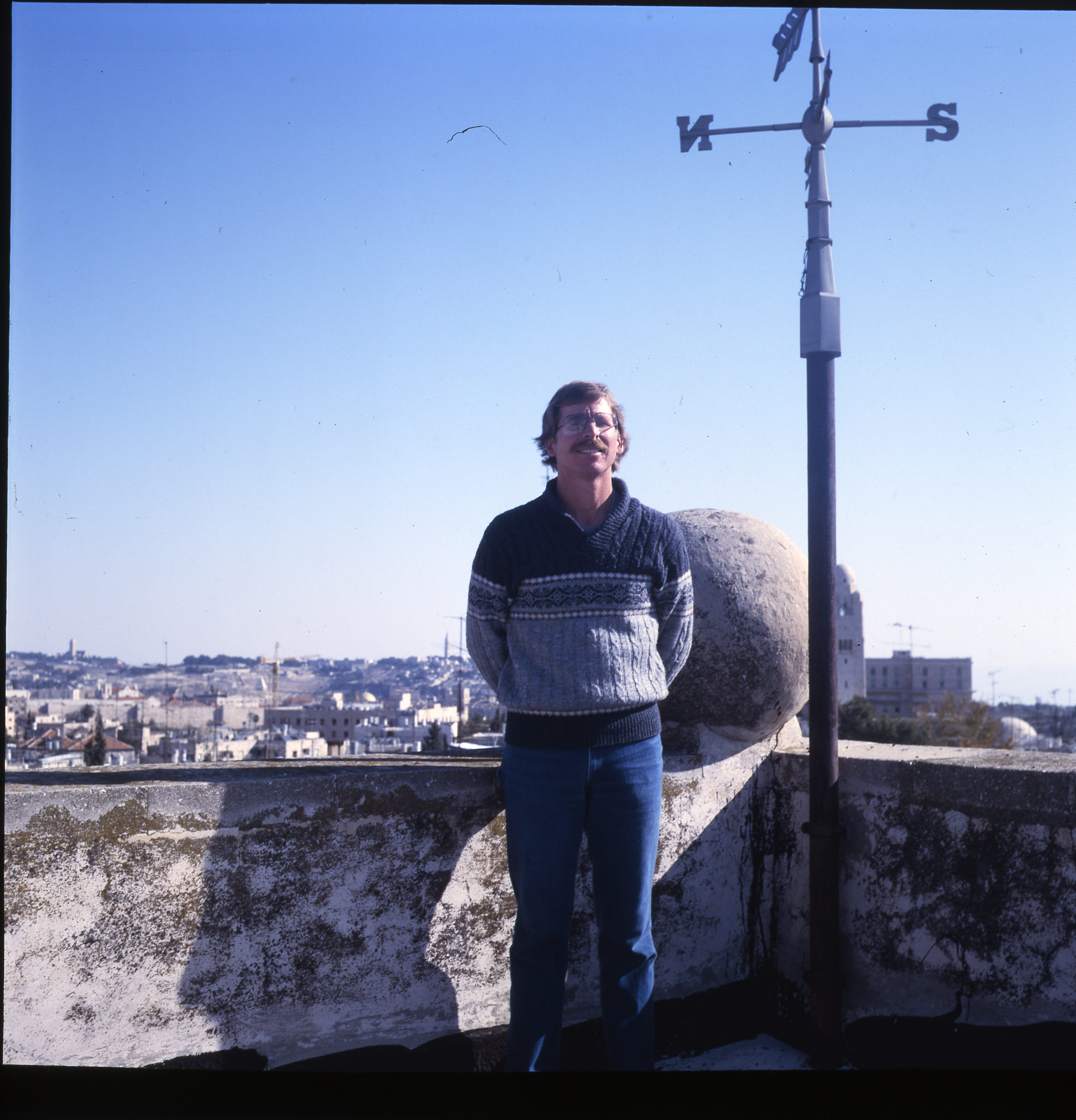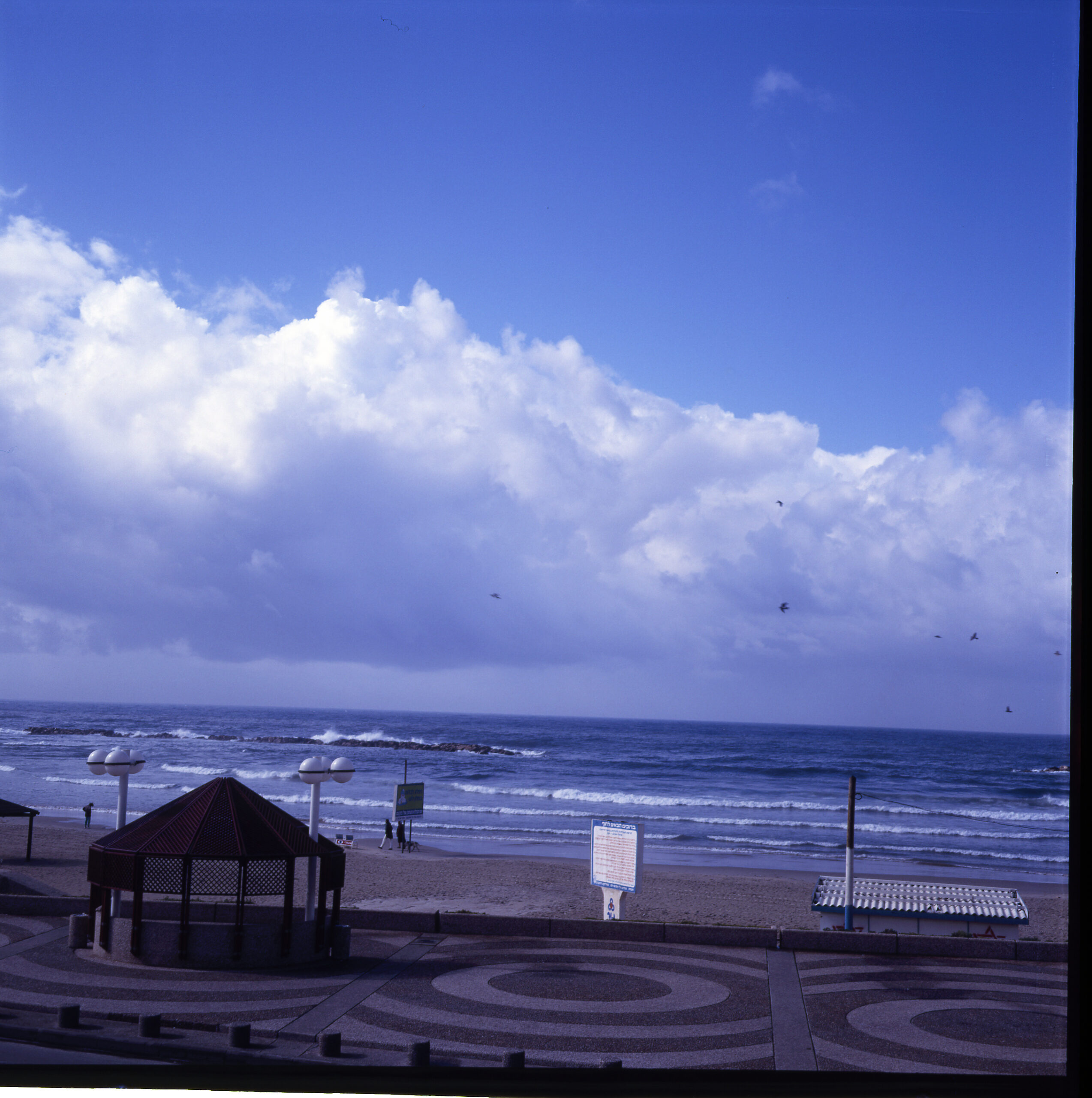The trip to Israel
My self-funded trip to Israel was one of 11 weeks, from January 4th through March 11th, 1986. I loved my time in Israel and would go back in a heartbeat any winter to see those beautiful Cumulus and Cumulonimbus clouds rolling in off the Mediterranean again!
Following my return and for the rest of 1986 I lived off my savings in Seattle to write up an analysis and draft of what I had found. Despite my resignation, Prof. Hobbs and I retained a civil relationship as I also finished grant work that I said would before resigning (which ended up being Rangno and Hobbs 1988, Atmos. Res., “Criteria for the Onset of Significant Ice Concentrations in Cumulus Clouds.” In this short 1988 paper, it was noted that the reports from Israel concerning the onset of ice in clouds was sharply at odds with similar clouds. I discussed why that might have been in the paper.
Prof. Hobbs also agreed to look over my drafts and figures of the Israeli cloud investigation as I brought them in to the University of Washington from time to time. Being who he was, Prof. Hobbs greeted me when I first dropped by the University of Washington upon my return from Israel with, “I doubt you’ll get a paper out of your trip.” However, I knew exactly what I had to do to pass journal muster because of the rejection of that 1983 paper. It was also evident that no American Meteorological Society journal was likely to accept a paper like the one I was putting together; too many potential reviewers had heard at conference or read in journal articles on too many occasions how Prof. Gagin had described Israel’s hard to rain natural clouds.
That I got any Israeli data at all to take home and analyze was to the credit and magnanimous view of my outside cloud inquiry by the Israel Meteorological Service (IMS), Director, Y. L. Tokatly, who gave me pretty much a free reign to examine historical balloon soundings and synoptic maps within their Climate Division. The Climate Division was headed by Sara Rubin, who was also friendly and extremely helpful. I was even given a little desk space in the climate division! I went there every day that there wasn’t a storm to experience, clouds to assess with this experienced eyeball and photograph while traveling all over central and northern Israel on their stupendous bus system. I had also crated my bicycle to Israel for local travel.
Here is the IMS Headquarters building I worked in and the little desk space they gave me, two of the several officemates I had, and a shot of the IMS map and briefing room.
Zohar Moar (?) working next to my little desk space in the Climate Division office of the IMS.
Ronit Ben-Sara and Geulah Siles in the climate division office.
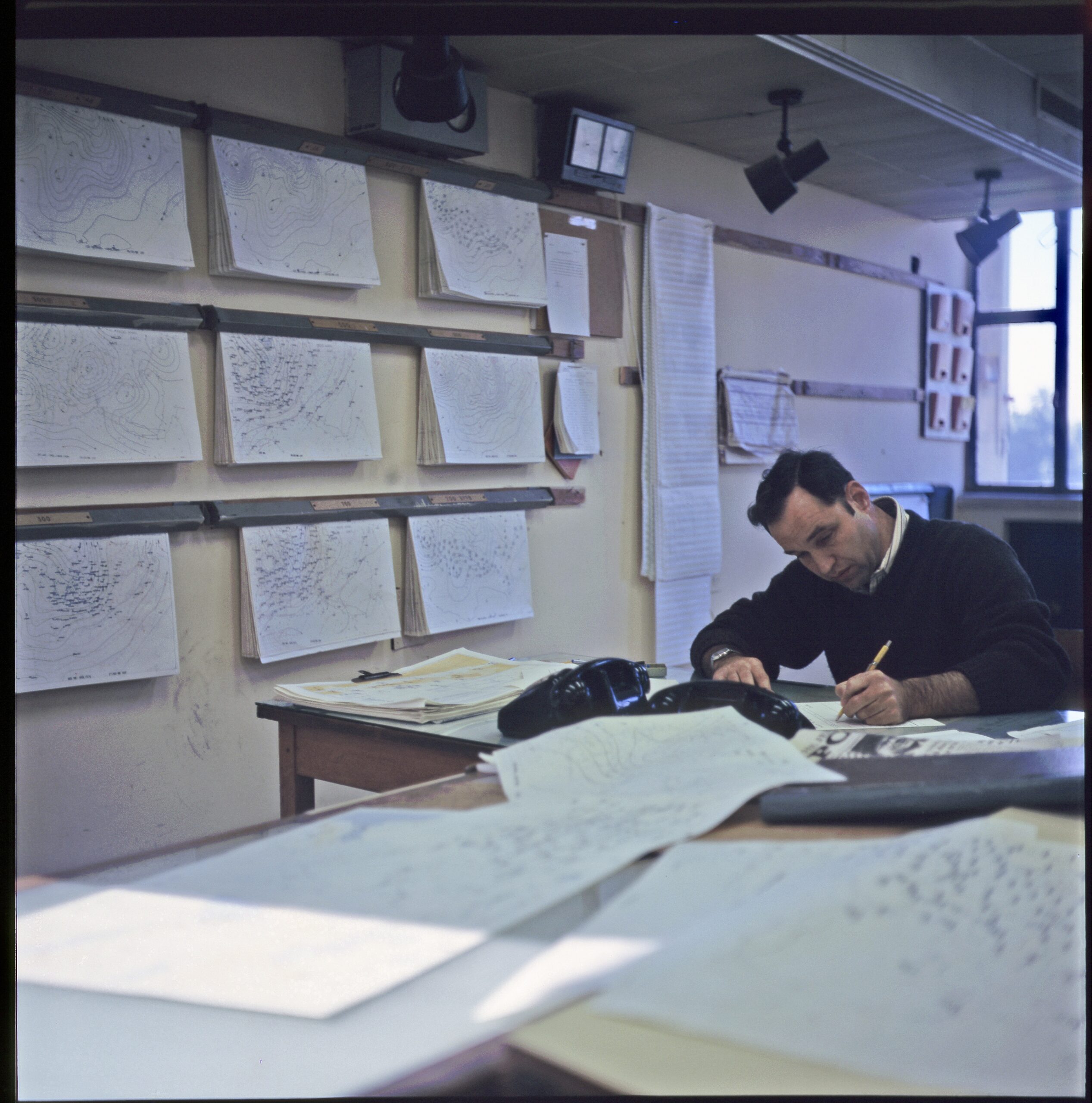
Forecaster Uri Batz in the IMS map room.
Below these is a list of the bus rides I took on ONE storm day, always sitting behind the driver and looking out the front window, recording drop sizes and nature of the rain on the front window::
In some interesting cases, such as in the hill region and the Golan Heights, I would get out and walk around in the wind and clouds, the latter often topping a hill region such as Jerusalem. I had my heaviest clothing, but it really wasn’t enough to keep me warm, and I had no gloves. Temperatures during storms were usually in the low 40s in Jerusalem with winds of 20-30 mph and passing showers. Once, I could not pull the shutter lever on my Rolliecord film camera to take a cloud photo my fingers were so cold.
This weather, too, really put an edge on those Bible stories. I could not imagine how miserable it really was for people living here in the winters. It even snows in Jerusalem from time to time as I saw myself in a January 1986 storm pocked with thunder. I listened to the IMS weather briefings most mornings, too. I was in heaven.
First Impressions
What was particularly interesting to me was that I encountered more skepticism about Israeli cloud seeding efforts in the IMS than there seemed to be in the entire world outside of it!
My first meeting with Prof. Gagin: January 10, 1986
It was an extremely cordial meeting in his office at the Rivat Gam branch of the Hebrew University of Jerusalem at the end of a dry week in Israel. That was followed by a family dinner at his residence where he regaled me with so many interesting stories. I really thought at that time that he didn’t mind my intrusion into his cloud seeding world, and I began to feel some guilt about it since he was so nice to me! But I had to persevere in my “task” I thought.
Prof. Gagin took this photo atop the HUJ satellite campus at Rivat Gam during that first meeting. He would not allow me to take his photo. I also suggested at this time that if I “found something” that perhaps we could co-author a paper. He deferred.
Not too surprisingly, all the weather forecasters I spoke with in the Israel Meteorological Service in 1986 were well aware that clouds much shallower than Prof. Gagin was describing as seeding targets, that is, those with tops >-10°C rained. It must have seemed bizarre to them that I had come 7,000 miles to document something they deemed so ordinary!
But where were Tel Aviv University atmospheric scientists in in these matters? Think how embarrassing it might be to all Israeli scientists to think that a minor foreign science worker had traveled thousands of miles to inform them about the true nature of their own clouds as they were described in the peer-reviewed literature!
You may have guessed the possible answer to this puzzle about the lack of involvement of other scientists in questioning or overturning Prof. Gagin’s cloud reports.
It turned out that considerable funding from cloud seeding operatives in Israel went to Tel Aviv University (Z. Levin, 1986, private conversation). He simply could not openly help me, he stated, in our one and only meeting. He also had trouble believing at that time that my cloud assessment (ice particles onset in Israeli clouds with tops between -5°C and -8°C, and that concentrations of “50-200” per liter were present by the time cloud tops reached -12°C, was correct. I wrote this same assessment following my 2nd meeting with Prof. Gagin to Professors Roscoe R. Braham, Jr., at North Carolina State University, Gabor Vali, University of Wyoming, Peter V. Hobbs and Lawrence F. Radke at the University of Washington, and to Dr. S. C. Mossop (of the Hallett-Mossop riming and splintering process). Why I wrote to them will become clear in the next segment.
January 19, 1986: My second meeting with Prof. Gagin
There had been several shower days in Israel when Prof. Gagin and I met for the second time. He asked me at the very beginning, after handing me a cup of coffee, “What have you found?”
I unloaded a boatload of findings contrary to his cloud reports. Suffice it to say, our meeting did not go well after that. In a sense, I was Professor Gagin’s nightmare; an under-credentialed worker coming to “his house” to expose faulty cloud reports. But, with his radars and aircraft, how could he possibly not have known that his reports were faulty?
I had also felt true drizzle falling in Jerusalem in the early morning hours during the very first storm. Drizzle tiny (<500 um in diameter) drops that are close together was something that was not supposed to occur in Israel due to the polluted nature of the clouds reported by Prof. Gagin. I certainly did not expect to see it, and when I stuck my hand out of my apartment window, I yelled, “drizzle?” to no one in particular.
Then, when I came down from Jerusalem on a bus that morning to the coastal plain, I was amazed by shallow, glaciating clouds (modest Cumulonimbus clouds) rolling in from the Mediterranean Sea. Namely, in less than three hours of the first storm, I had seen all I needed to know that Prof. Gagin’s clouds reports had described non-existent clouds.
In this 2nd meeting, I had brought with me an IMS sounding from Bet Dagan when rain was falling lightly throughout the hill region of Israel that had a cloud top, marked by a sharp inversion and strong drying, at -5°C. Professor Gagin was non-plussed by the sounding, stating that balloon soundings are unreliable for the purpose of assessing cloud top temperatures.
Prof. Gagin Had Heard Enough.
He informed me how offended he was by my visit to check his cloud reports. He asked me, “Who do you think you are, the Messiah, come to expose the liars?” He immediately then asked, “Did Hobbs send you?”
Peter Hobbs had not sent me5! !
I was reeling at that point in my meeting with Prof. Gagin, almost speechless even though I knew something like this, being bawled out, might happen. However, I did cough up an admonition: “Don’t be like Lew Grant,” referring to Grant’s stubbornness in accepting new information. Prof. Gagin replied, “I don’t appreciate the comparison.” This is the first time I have mentioned this quote. Prof. Grant deemed Abe Gagin a good friend and wrote a testimonial on his behalf when Prof. Gagin died. I would be willing to bet that Prof. Gagin later deeply regretted uttering that about Grant.
Before many more words were spoken, Prof. Gagin was escorting me out of his office and telling me not to come back; “Do your own thing,” he said. I went back to my apartment and wandered down King David boulevard in Jerusalem in kind of a haze.
For me, to “do your own thing” was continuing to gather historical data at the IMS on fair weather days and travel around eye-balling and photographing clouds and rain on storm days. I decided I needed to alert my former colleagues at the University of Washington and other scientists in this field about what had happened and what my so-called, “findings” were. I wrote to five leading scientists of the day, Prof. Peter V. Hobbs and Prof. Larry Radke at the University of Washington, the leaders of my former group, to Professor Roscoe R. Braham, Jr., at North Carolina State University, Professor Gabor Vali, at the University of Wyoming, and to Dr. S. C. Mossop at the Commonwealth Science and Industrial Organization in Australia. All wrote back except Hobbs and Radke who were on a field project in North Carolina.
All that replied supported what I was doing. Vali described my investigation as “spectacular,” and Mossop stated that I was a “genius for discovering sometimes unwelcome results.” Mossop was alluding also to my discovery of that an aircraft can create ice in clouds at temperatures around -10°C (Rangno and Hobbs 1983, J. Appl. Meteor.) a paper that had little credibility until confirmed in trials eight and 18 years later, it was that unexpected.
I felt an obligation to tell ASAP what had happened with Prof. Gagin to IMS Director, Y. L. Tokatly, in case he might wish to revoke my visitor privileges. He did not! He replied that it was just a difference of opinion, and I could continue to visit the IMS and gather data! How magnanimous was that?
February 3rd, 1986: My Third and Last Meeting with Prof. Gagin Takes Place at His Ben Gurion AP Radar.
A third meeting was arranged, despite what had happened in our 2nd meeting, after I learned that Prof. Gagin and his cloud seeding group had their own radar located on the outskirts of Ben Gurion AP. I did not even know that Prof. Gagin had his own radar at that point until informed of the “private radar” by an Israeli air traffic control person when I was looking for pilot reports of cloud tops! I had to call Prof. Gagin, as hard as that would be, and ask him about visiting it. A third meeting was arranged. Prof. Gagin was cooperative.
But what about that radar, located on the outskirts of Ben Gurion Airport? That radar would surely prove that Prof. Gagin was right and I was wrong; that rawin soundings indicating high cloud top temperatures of precipitating clouds were, indeed, unreliable as Prof. Gagin asserted.
I bicycled from my Riviera Hotel in Tel Aviv to this meeting. The sky was overcast in deep Altostratus (a mostly ice cloud) underlain by Altocumulus opacus clouds. A storm was approaching, but it would be hours before rain arrived. Below, a vertical look at those clouds from the site of the Ben Gurion radar as I was leaving.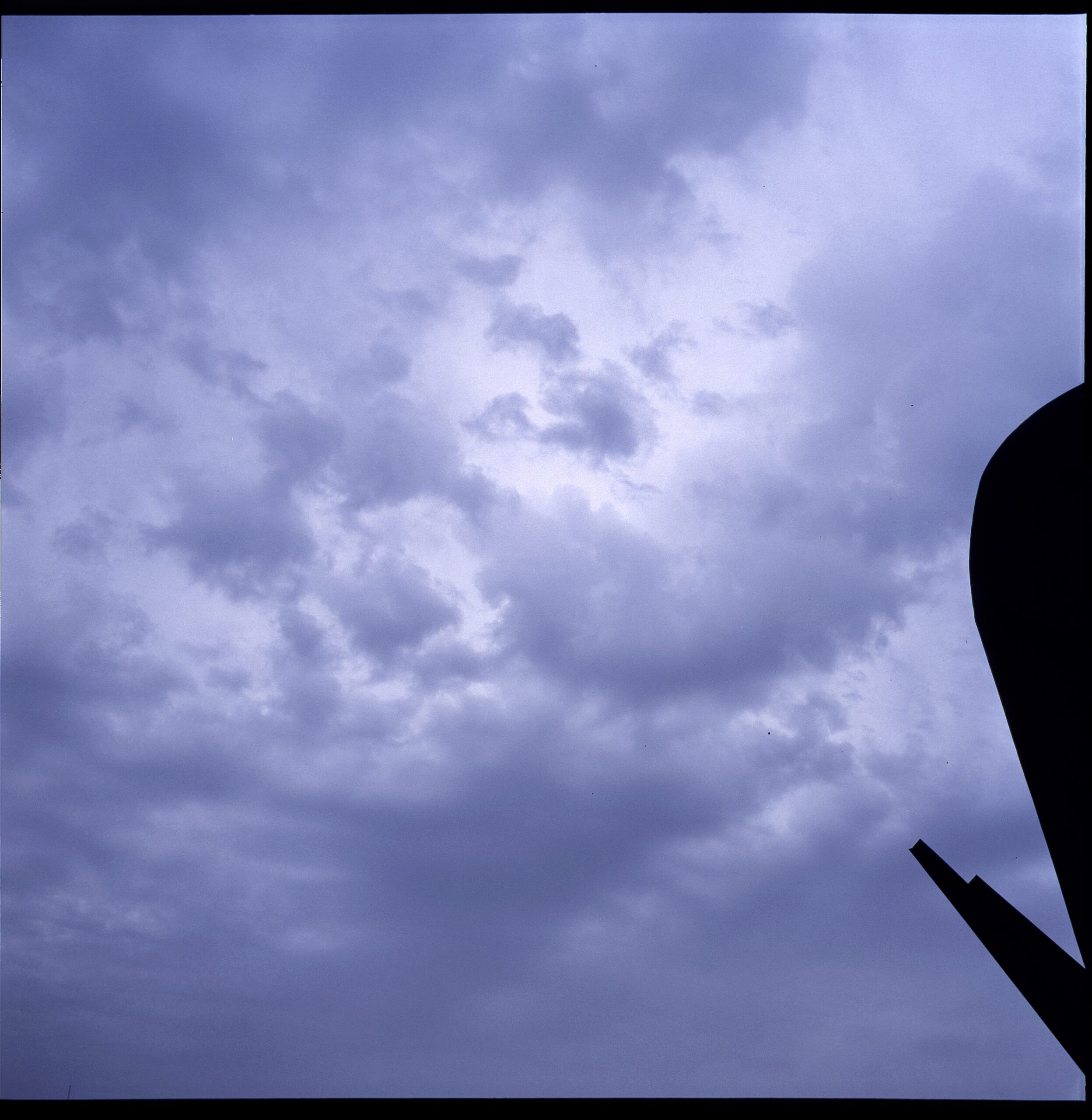
The main thing I wanted to ask Prof. Gagin in our third meeting was whether I could go to this radar during storms and see cloud top heights. He said “no,” giving “airport security” as the reason. He repeated to me how (understandably) offended he was by my visit to Israel to check his cloud reports.
But, “airport security?” I had just bicycled to his radar on the outskirts of Ben Gurion; no problem! Later, a grad student at Tel Aviv U. in Professor Zev Levin’s group, Graham Feingold, would erupt over the “airport security” claim as a lie, as it clearly seemed to to be at the time.
Prof. Gagin further assured me in this meeting at his radar that radar top measurements would only confirm his reports (that is, if I could only view those top heights on his radar!)
I also informed Prof. Gagin that due to his behavior in our 2nd meeting that I had asked several scientists around the world to intervene with him on my behalf. He asked me who I had written to and I told him (those listed earlier).
How crazy was this episode?
A minor, but well-known cloud seeding critic, as I was at that time, could be easily convinced that he was wrong by examining Prof. Gagin’s radar top height measurements. But he was denied the opportunity to be proved wrong!
Learning about private flying in Israel and then getting a pilot to be on “standby” for cloud sampling
Late in February, I learned that there was a robust private aircraft touring business in Israel. I had assumed, based on the reports of Professors Mason, Hobbs, and Vali, that research groups weren’t able to get in, that flying around in Israel to sample clouds couldn’t be done due to security issues. But then, how could there be a strong tourist flying program?
I then went to one of the aircraft touring sites at Sade Dov Airport near Tel Aviv, and found that I could get a single engine aircraft and pilot, Yoash Kushnir, who would sample the tippy tops of clouds along the coastline of Israel with me along. He said it would cost $250 an hour and I was willing to spend about $500 to do give it a try. His aircraft had a ceiling of about 14 kft as I recall, just “high enough” to sample cloud tops that would average >-10°C. Tippy tops is not the best place to find much ice. Higher concentrations of ice are found lower down when ice is developing, as a rule, unless the top has completely glaciated.
The pilot I had on standby, incidentally, was angry that it was believed outside of Israel that you couldn’t fly research in Israel and sample clouds. It was a presumption I had, too, because the University of Wyoming and the British teams were not able to get in to sample Israeli clouds. This pilot regularly flew tourists to view ruins at Masada and other historical sites in Israel.
While Prof. Levin felt he could not openly support my efforts due to funding issues, he did provide me with a graduate student, Graham Feingold, who was willing to go along on a flight. He would act as a witness to what was found in those “tippy tops.” I had planned to use the “black glove” technique used decades earlier in sampling clouds for the presence of ice. You literally stick a black-gloved hand (or a black stick) out of the window of the aircraft and look for what hits.
You can only imagine how crazy these people thought I was! Years later I learned that I had been described by Graham, who was to become my friend, as, “that cowboy from America.”
No flight ever took place as the weather dried out by the time l learned I could hire an aircraft to sample cloud tops. Ironically, the only rain after having Yoash Kushnir on standby fell briefly from clouds whose tops were near the freezing level, and likely, if I had flown that morning, no ice would have been found in them! It was a surprise weather event that produced barely measurable rain.
My Meeting with Israeli experiments’ “Chief Meteorologist,” Mr. Karl Rosner
Late in my 1986 cloud investigation, I met the Israeli cloud seeding experiments’ “Chief Meteorologist,” Mr. Karl Rosner. It was IMS’ scientist, Alexander Manes, that got me in touch with him. I learned that the chief meteorologist, too, knew that Israel clouds rained having tops warmer than -10°C! It then seemed that the only three people in Israel who did not know that rain fell from such clouds were those who studied them in great detail, Prof. Abe Gagin, his frequent co-author, Jehuda Neumann, and Prof. Gagin’s only graduate student, Daniel Rosenfeld!
But Mr. Rosner had a more important and astounding thing to tell me: Prof. Gagin had refused to publish the result of the south target random seeding for Israel-2. Mr. Rosner had launched a campaign to see that it got published. The results of the “full” Israel-2 experiment were published by Gabriel and Rosenfeld (1990). Prof. Gagin, his co-author, J. Neumann, had stated in their 1981 journal paper that the seeding of the south target was “non-experimental.” They wrote that this was due to the lack of a suitable coastal control zone like the that they used to evaluate the north target’s random seeding. Previously, in 1974 these authors had given the result of random seeding in the south target as suggesting a decrease in rain after two rain seasons, and by 1976 at conference, stated the south target results were inconclusive for the full Israel-2 experiment.
So, here I was questioning the cloud reports and then learning from Mr. Rosner that half of the Israel-2 experiment had not been reported! In Gabriel and Rosenfeld’s 1990, we learned that the “full” result of Israel-2 was a -2% suggested effect on rainfall; it had not replicated Israel-1 as was previously believed based on the partial reporting of Israel-2.
Some Speculation About Why Prof. Gagin Might Not Known Have Known About the Natural Precipitating Nature of Israeli Clouds
It may be that Prof. Gagin’s graduate student knew the true cloud/rain situation but did not pass that crucial information along. It does happen that lab directors and important scientists have staff and students who do all the research, and upper echelon scientists are not close to what’s being done by the lower echelon staff; the latter might not pass along all the relevant information if it goes against the beliefs of their bosses.
One must conjure up a dizzying amount of incompetence concerning the three principal Israeli cloud seeding researchers (Gagin, Neumann, and Rosenfeld) who could not identify the most basic aspects of their clouds; the depth and cloud top temperatures at which they started to rain.
But is an “incompetence” hypothesis credible? Or was it that a knowing graduate student did not pass along to Prof. Gagin information that would have eroded his cloud reports? Read on….
Prof. Gagin and his student had monitored cloud tops with a vertically-pointed radar with tops having been confirmed by aircraft flyovers. This was done for two rain seasons in the late 1970s (Gagin 1980, Atmos. Res.) Prof. Gagin made no mention in his article of the shallow raining clouds that violated his cloud reports, ones that had to have passed over his radar during those two rain seasons.
Dr. Rosenfeld studied radar data and satellite cloud patterns in his 1980 master’s thesis and 1982 Ph. D. dissertation2. Yet, he did not bring to his country’s attention or to the scientific community, those shallow raining clouds with relatively warm tops, either. Such reports, if outed, would have had a profound effect on the viability of cloud seeding to increase rain in Israel, perhaps saving the country 10s of millions of dollars in wasted seeding efforts, as we now know happened when an independent panel (Kessler et al. 2006) found no via evidence that cloud seeding for 27 rain seasons had increased runoff into Lake Kinneret (Sea of Galilee).
Moreover, these researchers were recording echo top data from their Enterprise 5-cm wavelength radar at Ben Gurion AP after it had been deployed in support of cloud seeding efforts in the late 1970s. Dr. Rosenfeld cited 1986 recorded radar top data in his 1997 “Comment” on the Rangno and Hobbs 1995 J. Appl. Meteor. paper. Another enigma.
A regret about stridency
My last communication to Prof. Gagin following my cloud investigation trip was from Seattle in June 1986. In that long letter I recapitulated the elements of my cloud investigation. This letter was copied to Prof. Peter Hobbs, Roscoe R. Braham, Jr.3, at North Carolina State University, and Prof. Gabor Vali at the University of Wyoming.
The one thing I came to regret was how I closed that June 1986 letter. I closed it with a challenge: That I, myself, would leave the field of meteorology, all aspects, if my Israeli cloud observations were wrong; that ice was not forming in high concentrations in Israeli clouds with top temperatures >-12°C (eyeballing 50-200 per liter as I wrote in my letters from my experience sampling glaciating clouds at the University of Washington). I then challenged Professor Gagin himself to leave the field of meteorology instead of me if my observations were later proved correct:
So, there I was, the person who was told to give up meteorology by Joanne Simpson, who believed that “statues will be raised in his honor” challenging that very professor to quit the field.
Joanne likely never remembered who I was, and I had a couple of cordial correspondences with her due to my cloud seeding reanalysis publications that began reaching the literature in the late 1970s and early 1980s. Later, when it was thought there was some overarching claims about “global warming,” she sent me her banquet talk given in October 1989 to a statistical conference, shown here to indicate this cordial relationship:
1990 1-22 Simpson, from, about GW and cloud seeding_color version_ocr
I wish I had gotten to know her.
The End
===============
Joanne Simpson’s homage to Prof. Gagin:
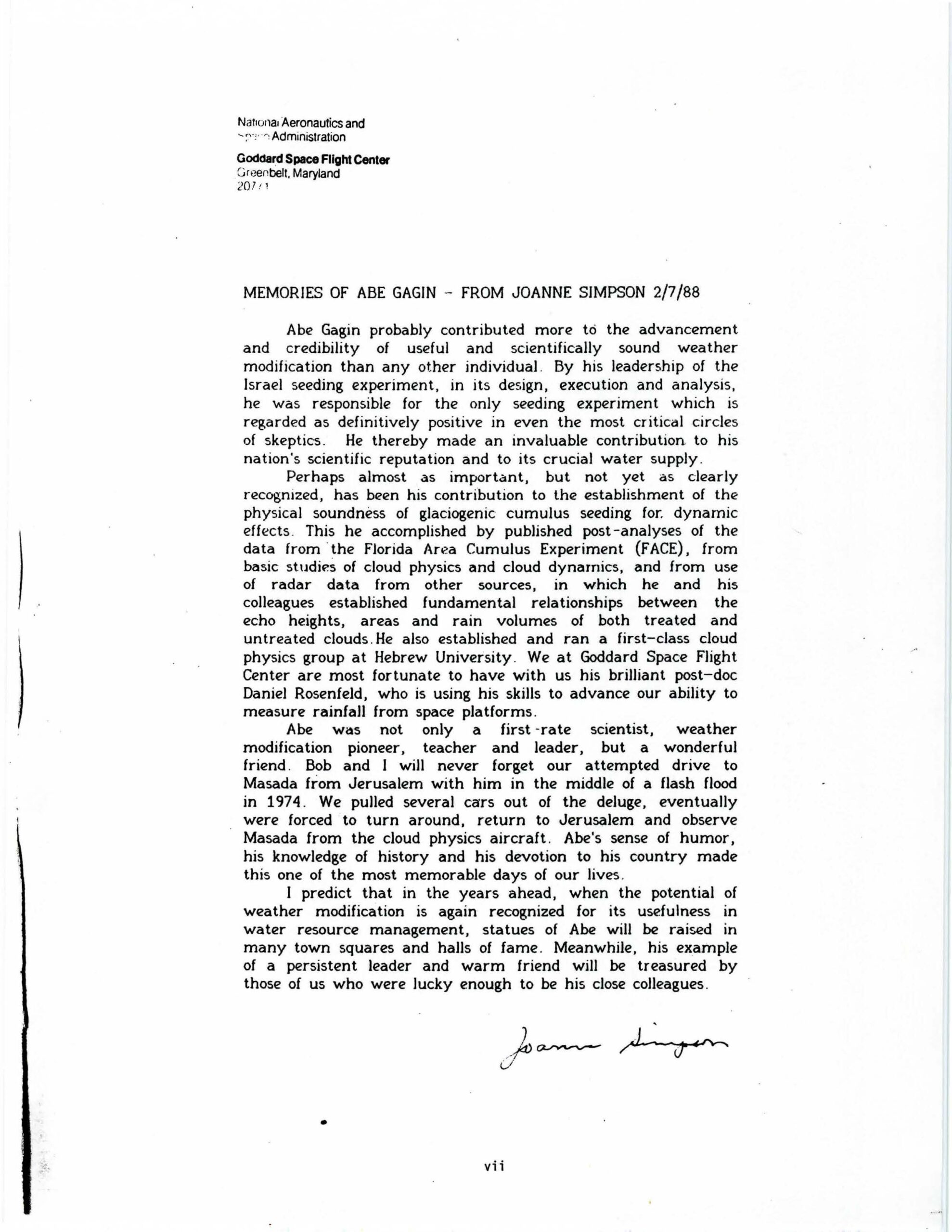 ==============================
==============================
1This was, and is even today (!), a sore point for me; that someone might believe this. Prof. Hobbs was clueless about Israeli cloud anomalies and the Israeli experiments except for those plots and information that I relayed to him while studying those experiments on my own time. As most professors would do, he read in the peer-reviewed literature and took it at face value.
2Rosenfeld’s works are in Hebrew and have never been translated into English, but should be.
3The full letter, and others that I wrote to Prof. Roscoe R. Braham, Jr., are in an archive of his professional correspondence at North Carolina State University.


